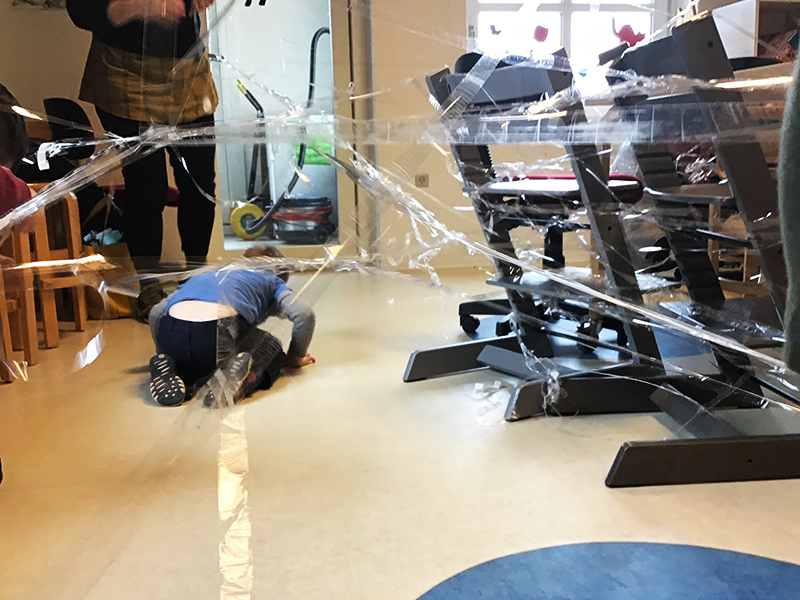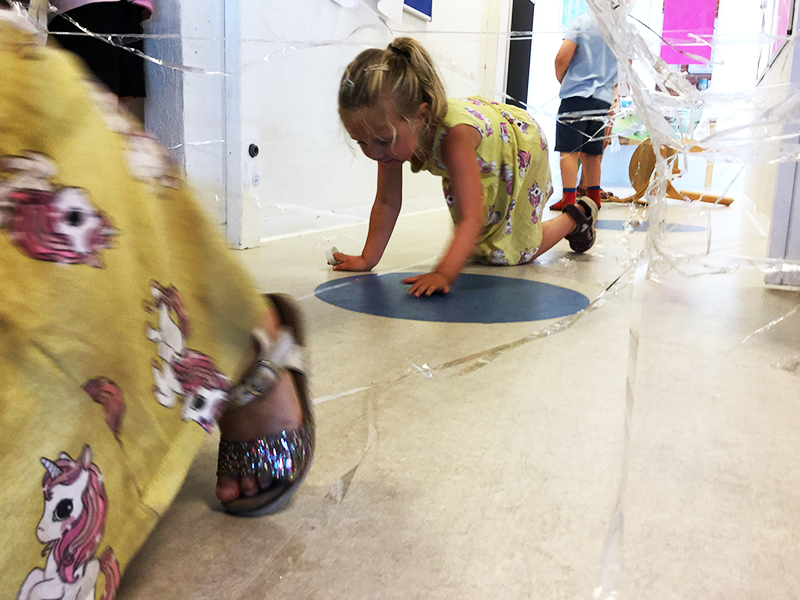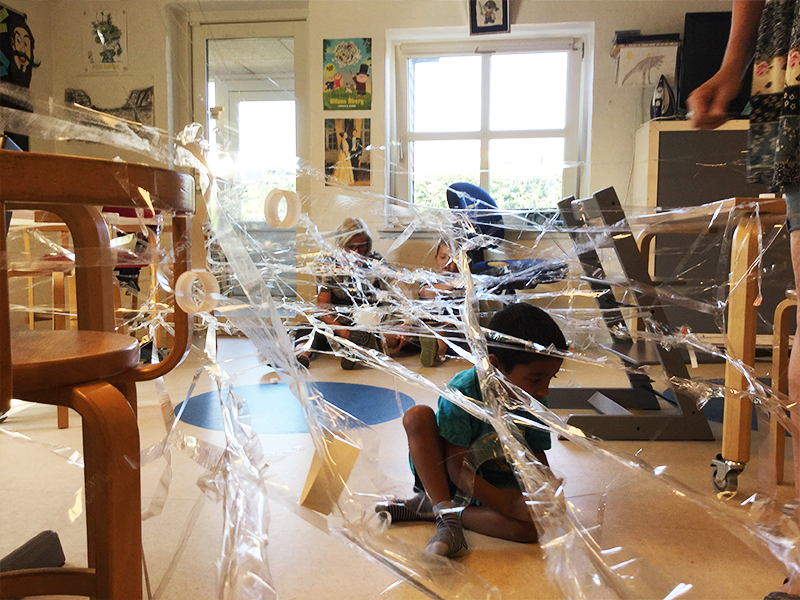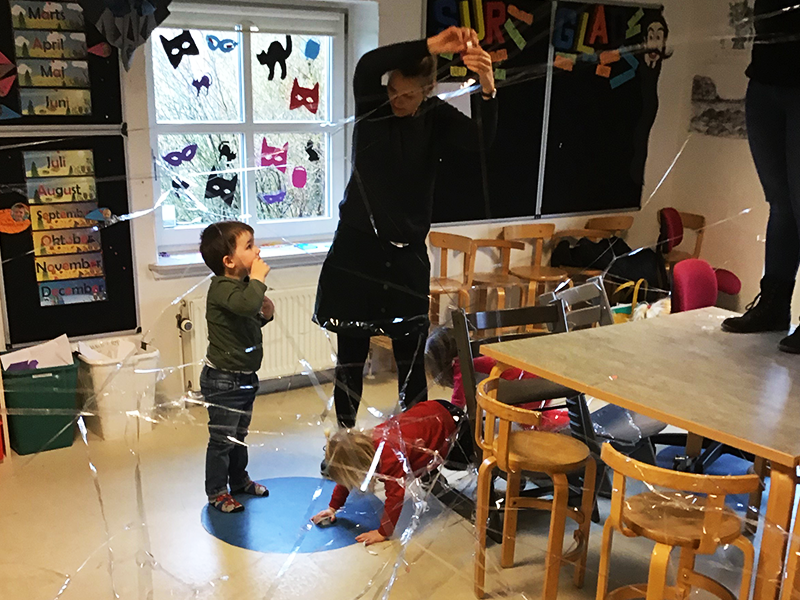ART, PAINTING, OUTDOOR LIFE, AESTHETIC PROCESSES, COMMUNITY
Region: North
Municipality: Frederikshavn
By: Frederikshavn
Year: 2020
Artist: Lina Franke Hedegaard
DAILY OFFER: Children's House Lærkereden
When curiosity, wonder and presence merge into an experimental practice
When we were invited to participate in the LegeKunst project, we first wanted inspiration for our practice. What activities did we not think we could do in everyday life? How could we work with aesthetic processes in a different way than before, and bring it into play in relation to the new reinforced curriculum? What is possible in a nursery and what is possible in a kindergarten?
Many questions were raised, and there was also a good deal of curiosity about how things would work in our institution.
In our nursery we are divided into groups, both in the nursery and in the kindergarten. The pedagogical staff chose to involve a few children from each room in order to be more present in the process. During the process, there was more courage to change the framework of the process, after which the staff wanted to try to see how it could happen if the whole rooms were involved - what difference in the process it would create for the individual child, but also for the adult and his role in it.
At the start of the project, the artist Lina Franke was in charge of each activity day, the educators were to be experimental with the children, and take a more withdrawn role, where instead of walking in front of the children, they would walk beside and behind in relation to the three learning spaces.
In the last part of the project, the pedagogical staff would take over the role of the artist, and the artist would be there observing and restraining.
However, the pedagogical staff had chosen the material they wanted to work with - in our institution we chose tape and paint. Tape and paint are often things that children want to use but where we find there is a limitation, perhaps because with our adult perspective we think of the product as the essential thing and not the process in which it is used. It's often a material that they have to ask permission to use, and why is that? What do children use tape and paint for and how, if they are to be experimental with it themselves? What happens when we adults have to follow the children's lead, and don't have a ready-made plan for what the process will result in as finished products. All these were interesting questions that we were also curious about.
The first times the children were puzzled, perhaps in fact mostly by the fact that there was free use of tape and paint, and not a set formula for what they could use it for. The artist Line led the way for the adults, showing them how she takes on the experimental role with the children.
Some children were immediately curious and jumped quickly into the process, while others were more reluctant.
The staff discovered how not pushing the children, but instead engaging in the activity in an experimental way, trying to use the materials in the same way as the children, makes a difference - when the children's perspective comes into focus and the adults join in, the atmosphere changes and the children, who were reluctant before, just as quietly became more and more comfortable with trying for themselves.
One of the staff members has since told how she has experienced a big difference in the outcome of the activity depending on her role. She has come to realise that in reality the product is more unimportant and the process has been what she experienced as the most important. A great realisation, as she says, because she has worked for many years with the idea that a product should always come out of aesthetic processes. Afterwards, we had many reflections on why this is the case? Whose fault is it that we emphasise the product? Do we have a preconception that the aesthetic process should result in a product, so that we can assess our quality as a day care centre by how many things the children can take home? Is this a way of showing that we are active with the children? Do we create this preconception ourselves through years of focus on the product?
Are we working from an approach where we need to be able to measure and weigh everything we deal with?
Snap narration:
I come down to the nursery early one morning to pass on a message.
The staff member sits on the floor, all the children walk quietly around her in the room. The room is very quiet and the atmosphere is buzzing, while the children's faces are smiling and interested. I notice that the staff member is sitting with a roll of yellow tape, and the children are walking around with several pieces of tape each. They look puzzled every time they discover that it can stick to something. The staff member follows the children's eyes and she mirrors their facial expressions every time they look at her. I squat down and watch them. After a while, one of the children spots me and comes over to see if the tape can stick to me - it can, and he smiles and laughs.
This situation shows an adult going behind the children and taking as a starting point what they are doing in the situation. She is experimenting and letting the children lead the way. She is aware of when the children make suggestions to her and mirrors these so that the children feel seen.
In our house, LegeKunst has inspired an everyday life where the children's perspective is highly valued. The project came alongside the fact that we are in the process of changing our pedagogical stance as we incorporate the strengthened curriculum, in which the child perspective plays a major role.
It has helped to change the atmosphere in the house in a way where everyone has become more aware of what it can look like in practice when we follow the children's tracks and do not always have predetermined goals with the processes that take place. Pedagogical work and aesthetic processes do not always have to be set in a fixed formula.
Today, the learning and experience of PlayArt is applied in many more ways. One staff member tells about how she went on a trip to the forest with the children and did not really set any goals for the trip, as she would have done before the PlayArt project. The trip was different, with wonder and amazement at the forefront. Time and place were almost forgotten, and she experienced a situation where she and the children were in flow.
It has been a very good experience to work with action learning because it has helped us to see things that we would not have seen otherwise. One child had a great sensory experience when we were working with paint, and action learning was a way to see that part of the child's experience, because action learning allows us to reflect together and from the observations we made in the situation.
LegeKunst will strengthen our work with the reinforced curriculum because we have now seen what action learning can do to develop our practice. We will think about it in our everyday life, where we can see that there is a need to think much more in how we can provide space for aesthetic processes for children and adults together. The experiences children and adults have together through this are enriching and crucial for our relational work. Meeting each child where he/she is and being interested in seeing their perspective, thus letting them be co-players in aesthetic processes, and not "just" participants, gives the child a sense of being an actor in his/her own life.
In our future work, we will continue to work with action learning in practice. We have already incorporated this into our way of working with the reinforced curriculum, whereby all wards across the institution have selected situations where they specifically engage in actions where observation, reflection and evaluation are circular, so that we are constantly mindful of where we can develop our practice to benefit children's wellbeing, development, learning and education.
We are still curious about how we can put the child perspective even more at the forefront. How can we create even more space for aesthetic processes, now that we have experienced what good developmental moments it can create in the institution for both children and adults together.
The PlayArt project has created space and opportunity for many good and greater reflections for the whole house practice. It has been an eye-opener to how little it really takes to create a change, and a different focus.
Head of Department
Marlene Jennet
click on the picture to see a larger version





